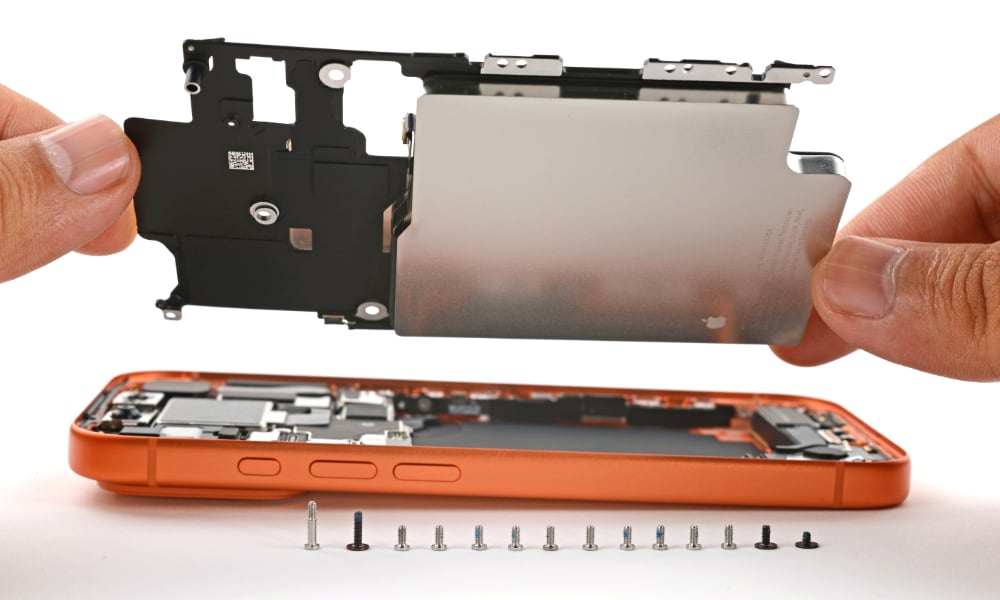iPhone 17 Pro Teardown Looks at New Cooling Tech and Scratching Fears
 iPhone 17 Pro Teardown [iFixit]
iPhone 17 Pro Teardown [iFixit]
Toggle Dark Mode
There’s little doubt that Apple has made some pretty big changes in this year’s iPhone lineup. With an entirely new and remarkably thin iPhone Air joined by two substantially redesigned iPhone 17 Pro models, the entry-level iPhone 17 appears to be the boring choice. However, there’s even more to that one than it looks, with an unprecedented bump to a 120 Hz ProMotion display and a starting capacity of 256 GB, bringing it in line with the rest of the family in a whole new way.
Once you get past the stunning design of the iPhone Air, it’s the iPhone 17 Pro and iPhone 17 Pro Max that are the real standouts in this year’s iPhone lineup. They get a new aluminum unibody design with vapor chamber cooling, a trio of 48 MP Fusion cameras, and a new cosmic orange finish that’s the most vibrant thing we’ve ever seen on an iPhone Pro.
Put simply, the iPhone 17 Pro models are more “pro” than they’ve ever been. Now, the folks at iFixit have done their usual teardown to find out what’s under the hood to make them that way, and they’ve made some interesting observations.
In an unusual twist, iFixit begins by discussing the elephant in the room: the seemingly high susceptibility to scratches of the aluminum body on this year’s models. Many (including myself) observed that the deep blue iPhone 17 Pro models in Apple Stores seemed unusually scuffed after only a few hours on display. This seemed to be unique to the darker, deep blue finish; the cosmic orange and silver models I looked at were pristine by comparison.
Apple has since pointed to worn MagSafe chargers in its stores. That part lines up with my own observations for at least some of the scuffs, as the back glass seemed discolored specifically by the MagSafe ring. However, it doesn’t explain how the iPhone 17 Pro models appeared so easily scratched and scuffed in parts other than the glass, and that’s where iFixit weighs in.
As others have speculated, the fault lies in the anodized aluminum finish on the new models, which is a significant departure from the all-glass backs that have been used over the past few years. While the iPhone 17 Pro models still feature a glass panel to accommodate MagSafe charging, this is now a distinctly separate component within an aluminum frame, which also encompasses the entire camera bump—an area that Apple now refers to as the “plateau,” as it also houses antennas and other electronics.
However, the real problem is with the anodized aluminum. In this case, the oxide layer itself is dyed, but beneath that surface, it’s still silver. A deep enough scratch will reveal the lower layer and therefore be readily apparent. That’s also why the silver iPhone 17 Pro models don’t appear to show scratches as visibly, and it’s a safe bet that cosmic orange being a bit close to silver also helps. The distinction is far more apparent when a darker shade, like deep blue, is used.
Anodizing is an electrolytic process that builds a protective oxide layer onto a metal surface. Basically, the metal surface is corroded carefully and the layer of corrosion protects the underlying metal. It’s also widely used as a robust way to add color, like the 17 Pro’s bright Cosmic Orange. The oxide layer is usually grown by submerging the part in an electrolyte bath and passing a current through it.
Elizabeth Chamberlain, iFixit
Anodizing works well on flat surfaces, but can be challenging for edges and abrupt geometry changes, such as the camera plateau. In those spots, the anodized layer becomes more brittle and is therefore more likely to flake or chip away, revealing the shiny silver aluminum underneath. It’s in these areas where the iPhone 17 Pro models are most vulnerable to visibly showing scratches.
This isn’t an entirely unavoidable consequence of anodizing. As David Niebuhr, owner of a metallurgical engineering firm, told iFixit, “Apple could have prevented this by making a more gradual curve and avoiding a relatively sharp corner.”
Apple is also using Ceramic Shield for the back glass this year, which seems like it may have contributed to the MagSafe discoloration, since the space black iPhone Air, which also used Ceramic Shield glass, appears to suffer from the same persistent MagSafe ring, while the black iPhone 17 display models (which don’t use Ceramic Shield) don’t show the same effect.
The Vapor Chamber
In addition to the other usual teardown trivia, iFixit delves into the new vapor chamber technology that Apple has included in this year’s models. As it points out, Apple is far from the first to incorporate a vapor chamber into a smartphone, but it appears to have done so in a more effective manner than most of its competitors.
The vapor chamber is modular rather than being permanently glued to the chassis, which enhances repairability — something the folks at iFixit are always thrilled to see. However, the benefits of the vapor chamber are also readily apparent when comparing the iPhone 17 Pro to its predecessor:
The chamber spreads heat from the A19 Pro chip into a water-filled copper lattice that boils, evaporates, and condenses in a constant loop. That cycle pulls heat away from the processor and into the phone’s frame. And now that the frame is aluminum, our thermal tests showed that while the 16 Pro Max started to throttle when the external temperature hit 37.8 °C (100 ?F), the 17 Pro kept humming at a steady 34.8 °C (94.6 °F). That might seem minor, but for anyone editing video or pushing graphics, that’s a meaningful win.
Elizabeth Chamberlain, iFixit
Is the iPhone 17 Pro More Repairable?
While the modular vapor chamber is a win, the iPhone 17 Pro overall is what iFixit calls “a mixed bag.”
The new models now feature a screwed-in battery, which is a first for Apple’s mobile devices. Although you need to remove fourteen Torx Plus screws to access it, that’s still a significant step away from the glued-in batteries of previous models.
The new aluminum unibody also has a downside that extends beyond being a potential scratch magnet. The new design eliminates the ability to remove the back panel for repairs, as the only back panel is the Ceramic Shield glass covering the wireless charging coils. This means that even a battery swap will require you to remove the front screen, which can be a considerably more delicate process.
Somewhat ironically, iFixit considers the iPhone Air slightly easier to repair. You’d expect the model to be more challenging, but it retains the old “dual-entry” design where the entire glass back can be removed. Nevertheless, iFixit gave both models a 7 out of 10 for repairability, noting that “Apple all-in-all is making some big steps in the repairability direction.”
All told, the iPhone 17 Pro balances cutting-edge cooling with some of its usual quirks in durability and repair design — proof that even Apple’s most professional iPhone still comes with trade-offs.









